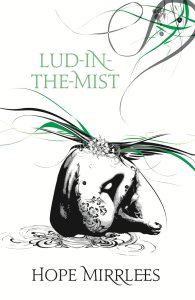 I’m going to be rereading Jonathan Strange & Mr Norrell for Tor.com starting in a couple of weeks [*], and to prepare for I’m doing a bit of research, posts about which will all be tagged as above. I started with Hope Mirrlees’ Lud-in-the-Mist because Jo Walton said that JS&MN “is clearly written from an alternate universe where” it, not Lord of the Rings, was “the great fantasy-defining genre-starting book of the twentieth century, after Dunsany.”
I’m going to be rereading Jonathan Strange & Mr Norrell for Tor.com starting in a couple of weeks [*], and to prepare for I’m doing a bit of research, posts about which will all be tagged as above. I started with Hope Mirrlees’ Lud-in-the-Mist because Jo Walton said that JS&MN “is clearly written from an alternate universe where” it, not Lord of the Rings, was “the great fantasy-defining genre-starting book of the twentieth century, after Dunsany.”
[*] Though not, thankyouverymuch, chapter-by-chapter as I did for LotR and The Hobbit, since the precipitating factor here is the BBC TV adaptation which is expected to be out around the end of the year and JS&MN has 69 chapters.
So this was published in 1926 and is about a town that borders on Fairyland; but, we are told on the first page, “There had, however, been no intercourse between the two countries for many centuries.” This is, however, not accurate: not much later, the reader is told that fairy fruit is still readily available in the town, though its consumption is “regarded as a loathsome and filthy vice.” Trade in fairy fruit is part of what drives the plot. But more broadly, the book is about exposing the inaccuracy of that first statement: where JS&MN is about the return of magic, Lud-in-the-Mist is about the acknowledgement of magic that never actually left. (Well, it’s more complicated than that, but that’s a topic for the reread.)
This is a weird, weird book, partly in the way it portrays magic—where the weirdness is appropriate, because it’s meant to be discomfiting—and partly in the way its tone and plot don’t cohere by the end, which I regard as unfortunate. And indeed, I think it’s interesting to look at JS&MN as taking a very (very!) broadly similar plot arc as Lud-in-the-Mist and devoting much more effort to arguing that the resolution is just.
Speaking of justice, my second reaction after finishing (after “that was weird”) was, “no-one told me it was about law!” This is a book set after the merchants kicked out the aristocracy, who had looked upon fairy things with reverence; the merchants banned everything fairy, but they “substituted law for fairy fruit”: “fairy was delusion, so was the law. At any rate, it was a sort of magic, moulding reality into any shape it chose. But, whereas fairy magic and delusion were for the cozening and robbing of man, the magic of the law was to his intention and for his welfare.” (There’s even a trial late in the book, though the technicality that permits it would never fly these days.)
In terms of relevance to JS&MN, there’s a quote from about halfway through that’s the only thing I highlighted while I was reading: “Reality was beginning to become very shadowy and menacing.” While a bare-bones and unpoetic way of putting it, the way that the books write about magic, and its interaction with what we would call ordinary life, feel similar to me. There’s the similarity, on the very broadest plot levels, of the plots’ concerns: they are books of extremely different scope, but they’re ultimately about the proper place of magic in their societies. There’s also possibly a certain similar ironic tone in the omniscient narration, though I think that JS&MN‘s narrator is a bit warmer (I also can’t remember if Lud-in-the-Mist‘s narrator ever uses “I” instead of the occasional “we.”).
Anyway, worth reading, glad I did, but strange book and I’m not sure I actively recommend it. However, it is currently in print in the US as well as the UK, so it’s at least easy for people to give it a try. (The US ebook covers showing at Amazon and B&N are kind of hilariously wrong. I’m using the current UK cover here, which is sufficiently abstract that I have no idea what it’s depicting, but at least is pretty.)
Regarding the cover pictured here: it looks like a nude female form, seated and bent at the waist slightly to the right, with her right arm bent at the elbow and away from her body. Stylized fairy wings on her back. I find it…unsettling? It does not look like a comfortable position.
I find it hard to resolve into anything definite, but that is definitely a possibility (and not one representing any particular scene in the book).